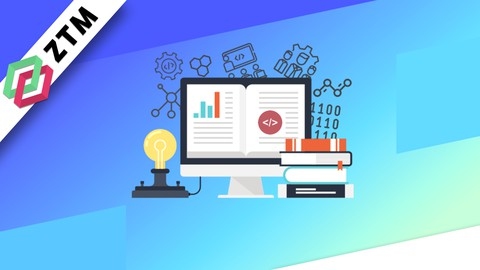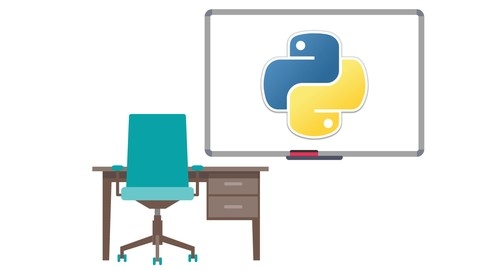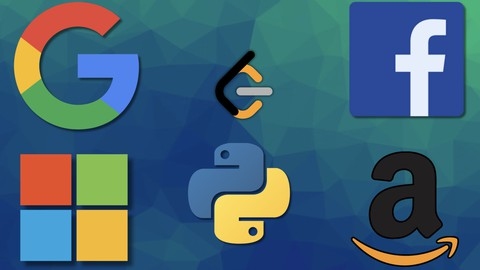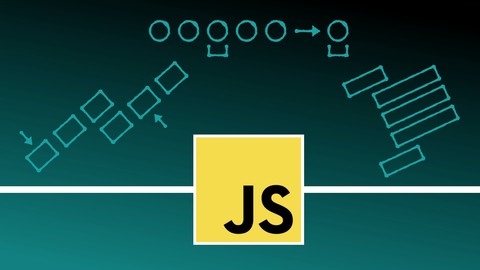Coding interviews are notoriously challenging, requiring not just strong programming skills but also a deep understanding of data structures and algorithms.
Mastering these concepts can drastically improve your chances of landing your dream job at top tech companies.
However, finding the right Udemy course to guide you through this journey can be overwhelming with the vast number of options available.
You’re looking for a course that goes beyond theory, providing practical experience and hands-on projects to solidify your understanding and give you the confidence to tackle any coding challenge.
Based on our analysis, Master the Coding Interview: Data Structures + Algorithms is the best course overall on Udemy for coding interview preparation.
This comprehensive program covers everything from fundamental data structures and algorithms to advanced concepts like dynamic programming and graph algorithms.
With hands-on exercises, mock interviews, and coding challenges from companies like Google, Amazon, and Facebook, this course provides a truly immersive experience that prepares you for any interview scenario.
While this is our top pick, there are many other excellent options available on Udemy.
We’ve also reviewed and listed other highly-rated courses, catering to different learning styles and preferences.
Whether you’re looking for a course focused on specific data structures, a problem-solving approach, or a language-specific guide, keep reading to find the perfect coding interview preparation course for your needs.
Master the Coding Interview: Data Structures + Algorithms
The course covers a wide range of topics, starting with strategies to increase your chances of getting more interviews.
It delves into the fundamentals of Big O notation, which is crucial for analyzing the efficiency of algorithms.
You’ll learn how to approach coding problems systematically, a skill that companies highly value.
The course then dives into various data structures, including arrays, hash tables, linked lists, stacks, queues, trees, and graphs.
For each data structure, you’ll learn its implementation, operations, and relevant coding exercises.
The algorithms section covers essential topics like recursion, sorting algorithms (bubble sort, selection sort, insertion sort, merge sort, and quick sort), searching techniques, breadth-first and depth-first traversals, and dynamic programming.
These concepts are reinforced with hands-on exercises and solutions.
Alongside the technical content, the course also prepares you for non-technical interviews.
You’ll learn how to craft compelling stories, handle common interview questions about yourself and your past projects, and negotiate job offers effectively.
The syllabus incorporates coding challenges from companies like Google, Amazon, and Facebook, giving you a taste of real-world interview questions.
Additionally, there are sections on contributing to open-source projects and extra resources to further enhance your learning experience.
Throughout the course, you’ll have access to coding environments for various programming languages, including Python, Java, C/C++, C#, Golang, Swift, Kotlin, TypeScript, Scala, and Perl.
This allows you to practice and reinforce the concepts in your preferred language.
The Coding Interview Bootcamp: Algorithms + Data Structures
This course starts with setting up the environment using Node.js, npm, and Git, ensuring you’re ready for the hands-on exercises.
You’ll dive into fundamental coding challenges like string reversal, palindrome detection, and integer reversal.
These exercises help you grasp essential problem-solving techniques.
The course then progresses to more advanced topics, such as the classic FizzBuzz problem, array chunking, and identifying anagrams.
As you move forward, you’ll tackle intriguing challenges like sentence capitalization, printing steps, and creating pyramids.
The course also covers finding vowels in strings and implementing matrix spirals, further enhancing your problem-solving abilities.
Importantly, you’ll gain a solid understanding of runtime complexity, a crucial concept in coding interviews.
The course explores the Fibonacci series to illustrate complexity analysis and optimization techniques like memoization.
It then delves into essential data structures like queues, stacks, and linked lists.
You’ll learn to implement these structures from scratch and perform operations like weaving queues, creating queues from stacks, and detecting circular linked lists.
The course also covers trees, including binary search trees.
You’ll learn to build, traverse, and validate these data structures.
Additionally, it explores eventing systems and design questions like “How to Build Twitter.”
Sorting algorithms are another key topic, with implementations of bubble sort, selection sort, and the divide-and-conquer approach of merge sort.
Throughout the course, you’ll engage in coding exercises and quizzes, reinforcing your understanding of the concepts.
The lectures provide multiple solutions and approaches, allowing you to analyze different problem-solving strategies.
Python for Data Structures, Algorithms, and Interviews!
The course starts with setting up your learning environment, guiding you through the course structure, and showing you how to access help and FAQs.
You’ll learn to identify the right company and job types for your career, craft a compelling resume using the best online tools, and establish a strong online presence with professional LinkedIn and GitHub profiles, plus your personal website.
The course emphasizes the importance of networking, offering strategies to expand your connections and leverage them for job opportunities.
Organizational tips for your job search are provided, including a curated list of job boards and company matching sites.
The interview preparation section is comprehensive, covering both technical and non-technical aspects, salary negotiation, and reference preparation.
On the technical front, the course dives deep into Python programming, from basics to advanced topics like Big O notation, array sequences, and graph algorithms.
Each module includes practical examples and interview problems to solve, ensuring you’re well-prepared for technical interviews.
Mock interviews with companies like an E-Commerce Company, a Large Search Engine Company, a Ride Share Start-Up, and a Social Network Company give you a taste of real-world interview scenarios.
Master the Coding Interview: Big Tech (FAANG) Interviews
This course prepares you for coding interviews at top tech companies like Google, Amazon, Facebook, Apple, and Netflix.
The syllabus covers a wide range of topics, from fundamental data structures and algorithms to advanced concepts like dynamic programming and graph algorithms.
You’ll start by tackling array-based coding questions, including classics like “Two Sum” and “Container With Most Water.”
The course walks you through brute force and optimized solutions, analyzing time and space complexities along the way.
It then moves on to string manipulation problems and introduces you to linked lists, where you’ll learn to reverse and perform M, N reversals.
The syllabus dives deep into recursion, covering topics like binary search and sorting algorithms like quicksort and merge sort.
You’ll also learn about trees, including binary trees, binary search trees (BSTs), and traversal algorithms like DFS and BFS.
The course covers advanced topics like heaps, priority queues, 2D arrays, and graph algorithms like Dijkstra’s and Bellman-Ford’s algorithms.
Dynamic programming is a significant focus, with questions like “Minimum Cost of Climbing Stairs” and “Knight Probability in Chessboard” to help you master the technique.
You’ll also learn backtracking through the “Sudoku Solver” problem and explore interface design with the “Monarchy” question.
The course includes additional sections on Big O notation, arrays, hash tables, linked lists, stacks, queues, trees, searching algorithms, and sorting algorithms like bubble sort, selection sort, and insertion sort.
11 Essential Coding Interview Questions + Coding Exercises!
This course covers a wide range of topics and question types that are commonly asked in interviews.
You’ll start with an introduction that explains what a typical coding interview is like and learn three effective problem-solving techniques to approach these types of questions.
This lays a solid foundation before diving into the actual coding problems.
The core of the course is divided into four chapters - Arrays, Strings, Two-Dimensional Arrays, and Linked Lists & Trees.
Each chapter has several lectures that explain a specific coding problem, followed by exercises in Python and Java to practice solving that problem.
After attempting the exercises, you can watch the solution video to review the optimal approach.
In the Arrays chapter, you’ll tackle problems like finding the most frequent element, common elements in sorted arrays, and checking if one array is a rotation of another.
The Strings chapter covers finding the non-repeating character and checking if two strings are “one away” from each other.
The Two-Dimensional Arrays section is particularly interesting, with problems related to Minesweeper - assigning numbers and finding where to expand on the board.
You’ll also learn how to rotate a 2D array, which has applications in image processing.
Finally, the Linked Lists and Trees chapter covers finding the N-th element, checking if a binary tree is a valid binary search tree, and finding the lowest common ancestor of two nodes.
What’s great is that the problems range from easy to difficult, denoted by * to ***, so you can gradually build up your skills.
The solutions are provided in both Python and Java, catering to your preferred language.
Some solutions are also explained in pseudocode for better understanding.
Data Structures & Algorithms, Level-up for Coding Interviews
The course starts with an introduction and guidelines on how to approach it effectively.
It then dives into arrays, vectors, and string manipulation problems, which are fundamental topics in coding interviews.
You’ll learn techniques like sliding window, bit manipulation, and recursion through hands-on exercises and quizzes.
As you progress, the course covers essential data structures and algorithms such as linked lists, stacks, queues, trees (binary, BST), heaps, hashing, and tries.
Each topic is accompanied by conceptual lectures, code implementations, and challenging problems to reinforce your understanding.
The course dedicates significant time to graph theory, exploring graph representations, traversals (BFS, DFS), and algorithms like Dijkstra’s and cycle detection.
You’ll also learn to solve complex problems by combining data structures, like the “Board Game” problem that utilizes tries, backtracking, and graphs.
Dynamic programming is a crucial topic, and the course covers both 1D and 2D DP problems in detail, including examples like coin change, longest common subsequence, and knapsack.
You’ll learn to identify DP problems and apply top-down and bottom-up approaches to solve them efficiently.
Towards the end, you’ll work on a real-life project: implementing an LRU cache using a combination of linked lists and hash maps.
This hands-on experience will solidify your understanding of data structures and their practical applications.
Throughout the course, you’ll encounter a variety of quizzes, coding exercises, and MCQs to test your knowledge and problem-solving abilities.
The course also provides resources like code repositories, TA support, and webinars to enhance your learning experience.
JavaScript Data Structures & Algorithms + LEETCODE Exercises
The journey begins with an introduction to the basics, including setting up your code editor, followed by a deep dive into Big O notation.
This section is crucial for understanding algorithm efficiency, covering everything from O(n) to O(log n), and teaching you how to evaluate your code’s performance effectively.
The course then moves on to Classes and Pointers, essential for grasping more complex data structures.
You’ll explore Linked Lists (LL) and Doubly Linked Lists (DLL), learning their inner workings and practicing with coding exercises.
These sections also include targeted interview and LEETCODE exercises, sharpening your problem-solving skills.
Stacks and Queues are next, where you’ll learn their implementation and analyze their performance.
The course ensures you get hands-on experience through coding exercises and interview questions, reinforcing your understanding.
In the Trees and Graphs sections, you’ll tackle Binary Search Trees (BST) and delve into graph theories.
These modules are packed with exercises that challenge you to apply what you’ve learned, from tree traversals to graph algorithms.
Sorting algorithms form a core part of the curriculum, with detailed lessons on Bubble Sort, Selection Sort, Insertion Sort, Merge Sort, and Quick Sort.
Each algorithm is accompanied by practical coding exercises and interview questions, preparing you for real-world applications.
Dynamic Programming is covered extensively, focusing on strategies like memoization and bottom-up approaches.
You’ll apply these to various problems, including the Fibonacci sequence, enhancing your problem-solving repertoire.
The course concludes with a series of coding exercises across a broad spectrum of topics, from arrays to dynamic programming.
These exercises test your knowledge and readiness for technical interviews.
LEETCODE In Python: Algorithms Coding Interview Questions
The course starts with an introduction and then dives into various problem categories like arrays, math, hash tables/dictionaries, linked lists, backtracking, trees, stacks, queues, dynamic programming, and more.
You’ll learn how to approach and solve popular coding interview questions from top tech companies like Google, Amazon, Facebook, Microsoft, and others.
The course provides a comprehensive understanding of each problem, including explanations, intuitions, pseudocode walkthroughs, and multiple approaches for solving them.
For example, in the array section, you’ll tackle questions like “Container with Most Water” from Microsoft, “Valid Mountain Array” from Google, and “Move Zeroes” from Facebook.
The course will guide you through brute force solutions, optimized approaches, and efficient implementations.
Moving on, you’ll explore hash table/dictionary problems like “Two Sum” from Google, “Group Anagrams” from Facebook, and the challenging “Minimum Window Substring” from LinkedIn.
These problems will help you understand the power of hash tables and how to leverage them effectively.
The linked list section covers essential problems like “Merge Two Sorted Lists” from Apple, “Reverse Linked List” from Microsoft, and the tricky “Add Two Numbers” from Adobe.
You’ll learn various techniques for manipulating linked lists, such as reversing, merging, and performing arithmetic operations.
The course also covers backtracking problems like “Subsets” from Facebook, “Letter Combinations of a Phone Number” from Amazon, and “Palindrome Partitioning” from Bloomberg.
These problems will teach you how to visualize and understand recursive and backtracking solutions.
In the trees section, you’ll tackle questions like “Symmetric Trees” from Microsoft, “Lowest Common Ancestor of a Binary Tree” from Facebook, and the challenging “Binary Tree Maximum Path Sum” from Microsoft.
You’ll learn various tree traversal techniques and how to solve problems involving binary trees and binary search trees (BSTs).
The dynamic programming section covers popular problems like “House Robber” from Google, “Best Time to Buy and Sell Stocks” from Facebook, and the challenging “Trapping Rain Water” from Amazon.
You’ll learn how to identify and solve problems using dynamic programming techniques.
Additionally, the course includes optional sections on Big O notation, binary search, sliding window technique, hash tables, linked lists, stacks, queues, graphs, depth-first search (DFS), breadth-first search (BFS), Dijkstra’s algorithm, trees, and binary search trees.
These sections provide a solid foundation in data structures and algorithms, which are essential for coding interviews.
LeetCode in Java: Algorithms Coding Interview Questions
The course starts with an introduction and then dives into integer-based problems like FizzBuzz, Single Number, and Palindrome Number from companies like LinkedIn, Amazon, and Facebook.
You’ll then move on to string manipulation problems such as Reverse String, Longest Common Prefix, and the challenging Longest Palindromic Substring asked by companies like Microsoft, Facebook, and Google.
The syllabus covers binary search algorithms like Search in Rotated Sorted Array from Facebook.
Array problems form a significant part, including classics like Two Sum from Google, Best Time to Buy and Sell Stock from Facebook/Microsoft, and advanced problems like Product of Array Except Self from Facebook.
Two-pointer techniques are covered through problems like 3Sum from Facebook.
The course dives deep into data structures like stacks, queues, linked lists, binary trees, binary search trees, tries, and heaps.
You’ll learn to solve problems like Valid Parentheses from Facebook, Reverse Linked List from Google/Facebook, and Implement Trie from Amazon/Microsoft.
Recursion and backtracking are covered extensively with problems like Permutations from Google, Combinations from Google/Facebook/Amazon, and the challenging Partition to K Equal Sum Subsets from Microsoft.
Graph theory concepts like BFS, DFS, and topological sort are taught using problems from companies like Samsung, Microsoft, and Google.
Finally, you’ll learn essential dynamic programming patterns through problems like Climbing Stairs from Google/Microsoft/Amazon, Coin Change from Amazon/Microsoft, and the famous Edit Distance problem asked by Google, Amazon, and Microsoft.
The syllabus also covers bit manipulation problems.
JavaScript Interview Prep: Practice Problems
The course starts with an introduction, guiding you on how to make the most of the learning experience.
It then dives into a series of coding challenges, each presented with a question video and source code.
Solutions are provided through detailed video explanations and source code walkthroughs.
Some key topics covered include triple add functions, IIFEs (Immediately Invoked Function Expressions), closures, the “this” keyword, hoisting, scope, equality operators, logging functions, strict mode, currying, counters, “call” and “apply” methods, JSON data manipulation, object creation, data types, the bind method, array constructors and methods like indexOf, handling equivalent numbers, and manipulating objects, strings, and arrays.
The problems range from beginner to advanced levels, ensuring a comprehensive preparation.
You’ll learn to work with JavaScript concepts like functions, objects, arrays, strings, and more in the context of coding interviews.
The source code examples and video solutions provide a hands-on learning experience, allowing you to see the thought process behind each solution.










